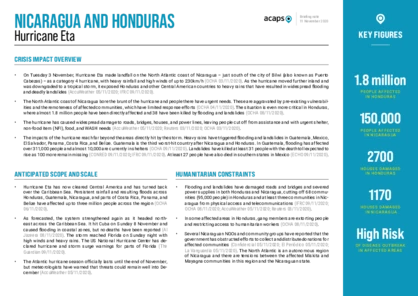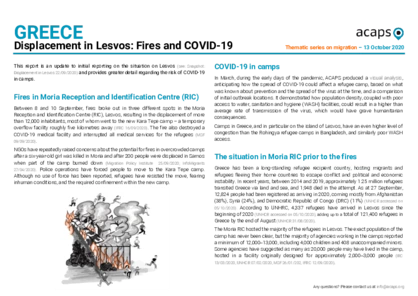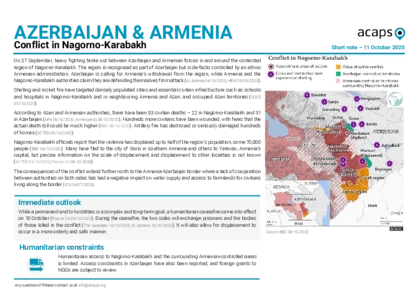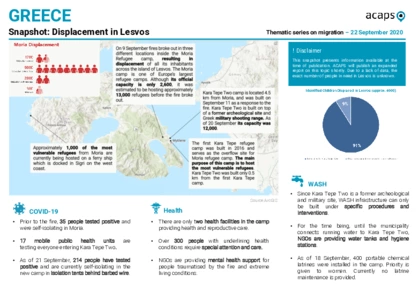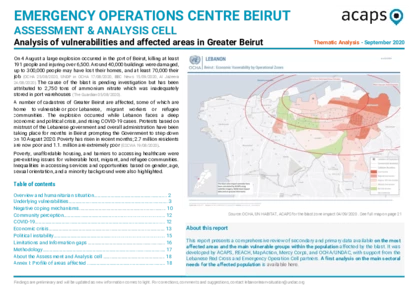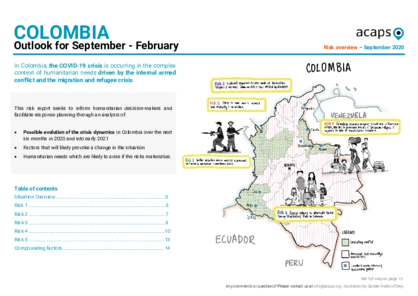Explore our
analysis products
archive
12 November 2020
Philippines: Typhoon Goni
DOCUMENT / PDF / 424 KB
On the morning of 1 November 2020, Typhoon Goni (known locally as Rolly) made landfall in Bicol Region and hit the town of Tiwi in Albay province, causing rivers to overflow and flood much of the region. The typhoon – considered the world’s strongest typhoon so far this year – had maximum sustained winds of 225 km/h and gustiness of up to 280 km/h, moving at 25 km/h.
11 November 2020
Honduras and Nicaragua: Hurricane Eta
DOCUMENT / PDF / 330 KB
On Tuesday 3 November, Hurricane Eta made landfall on the North Atlantic coast of Nicaragua. As the hurricane moved further inland and was downgraded to a tropical storm, it exposed Honduras and other Central American countries to heavy rains that have resulted in widespread flooding and deadly landslides.
09 November 2020
Iraq: Impact of COVID-19 on Education
DOCUMENT / PDF / 896 KB
This analysis illustrates the potential impact on humanitarian needs that ongoing crises in Iraq are likely to have at the individual, family, community, and state levels. The analysis also identifies population groups that are likely to be disproportionately affected by these crises.
04 November 2020
Global analysis of COVID-19 impact on education
DOCUMENT / PDF / 2 MB
Worldwide school closures, alongside other secondary impacts of the COVID-19 pandemic, are projected to have far-reaching implications in the short and the long term for children, their families, and their communities.
03 November 2020
Latin America: COVID-19 and impact on education
DOCUMENT / PDF / 513 KB
As at 29 October 2020, Latin America had reported close to 10.9 million cases of COVID-19 and close to 393,000 deaths. Most schools in the region have remained closed since initial lockdown in March. Only two countries, Nicaragua and Uruguay, have fully reopened schools, while Argentina, Brazil, Chile, and Colombia have partially reopened schools.
Attached resources
23 October 2020
Global gender analysis on COVID-19 and livelihood
DOCUMENT / PDF / 945 KB
This report is an overview of the gendered impact of COVID-19 on the livelihoods, income and employment of women, men, girls, and boys in different countries affected by humanitarian crises. The report explores lessons learned from previous epidemics to illustrate how women, men, girls, and boys were affected differently in their livelihood prospects and coping capacities.
22 October 2020
Global gender analysis on COVID-19, health and protection
DOCUMENT / PDF / 758 KB
This thematic report is part of the ACAPS Gender & COVID-19 series providing global analysis on the gendered impact of the pandemic in key areas of humanitarian programming such as livelihood, income and employment or health and protection. The report focuses on countries experiencing humanitarian crises which have undertaken gender analyses at the national and subnational levels.
19 October 2020
DRC: Impact of COVID-19, conflict and policy reforms on education
DOCUMENT / PDF / 486 KB
This report was produced in collaboration with partners in DRC’s DRC Education Cluster and Child Protection Sub-Cluster to support analysis contributions to the 2021 DRC Humanitarian Needs Overview. Its primary sources are a selected number of rapid needs assessments undertaken across four provinces in Eastern DRC.
Attached resources
15 October 2020
Burkina Faso: COVID-19, insecurity and education
DOCUMENT / PDF / 318 KB
This report is based on a review of publicly available information along with an interview of a key informant from a humanitarian organisation in Burkina Faso. There are significant information gaps concerning the exposure of children to armed group recruitment.
Attached resources
13 October 2020
Greece: Fires and COVID-19 caused displacement in Lesvos
DOCUMENT / PDF / 685 KB
This report is an update to initial reporting on the situation on Lesvos (Displacement in Lesvos 22/09/2020) and provides greater detail regarding the risk of COVID-19 in camps. Between 8 and 10 September, fires broke out in three different spots in Lesvos, resulting in the displacement of more than 12,000 inhabitants.The fire also destroyed a COVID-19 medical facility and interrupted all medical services for the refugees.
13 October 2020
COVID-19 and Migrant Vulnerability in Bangladesh, India and Nepal
DOCUMENT / PDF / 285 KB
This report aims to describe key factors affecting vulnerability for both internal and international labour migrants and the communities they are returning to in Bangladesh, India and Nepal, in order to support humanitarian and development actors to proactively identify and respond to emerging critical needs.
11 October 2020
Azerbaijan & Armenia: Conflict in Nagorno-Karabakh
DOCUMENT / PDF / 443 KB
On 27 September, heavy fighting broke out between Azerbaijan and Armenian forces in and around the contested region of Nagorno-Karabakh. The region is recognised as part of Azerbaijan but is de-facto controlled by an ethnic Armenian administration. Azerbaijan is calling for Armenia’s withdrawal from the region, while Armenia and the Nagorno-Karabakh authorities claim they are defending themselves from attack.
06 October 2020
Flooding in Chad, Niger and Nigeria
DOCUMENT / PDF / 367 KB
Heavy rains have caused extensive flooding in Chad, Niger and Nigeria since the onset of rainy seasons in June. Chad’s rainy season, expected to last until October, is the heaviest in the past 30 years. Flooding in Niger has affected almost twice the estimated population. Flooding in Nigeria is less widespread than in 2019, but is still significant.
06 October 2020
Bangladesh: Characteristics of vulnerable households in the Rohingya refugee response
DOCUMENT / PDF / 418 KB
The report and audio discussion - the first in a series of pilot audio discussions on work done by the ACAPS-NPM Analysis Hub in Cox's Bazar - highlights the common household characteristics of vulnerability, with the aim of identifying the specific needs and support requirements of the most vulnerable.
Attached resources
02 October 2020
Yemen: CrisisInSight Impact Overview January to August 2020
DOCUMENT / PDF / 865 KB
The Yemen Crisis Impact Overview provides decision-makers with a short, accessible overview of key trends and emerging challenges that may affect humanitarian needs in Yemen. The product combines trends in key conflict and humanitarian data with daily media monitoring, secondary data review, and ongoing joint analysis with a broad spectrum of Yemen analysts.
01 October 2020
Bangladesh: Upazila Profiles in Cox's Bazar
DOCUMENT / PDF / 2 MB
This review considers all eight upazilas of Cox’s Bazar. The profiles seek to provide a better understanding of the risks and vulnerabilities faced by Bangladeshi communities and to strengthen programming within Cox’s Bazar. They are not intended to measure the level of response.
22 September 2020
Greece: Displacement in Lesvos
DOCUMENT / PDF / 398 KB
On 9 September fires broke out in three different locations inside the Moria Refugee camp, resulting in displacement of all its inhabitants across the island of Lesvos. The Moria camp is one of Europe's largest refugee camps. Although its official capacity is only 2,600 it was estimated to be hosting approximately 13,000 refugees before the fire broke out.
22 September 2020
Lebanon: Vulnerable and Affected Areas in Greater Beirut
DOCUMENT / PDF / 1 MB
This report presents a comprehensive review of secondary and primary data available on the most affected areas and the main vulnerable groups within the population affected by the blast. It was developed by ACAPS, REACH, MapAction, Mercy Corps, and OCHA/UNDAC, with support from the Lebanese Red Cross and Emergency Operation Cell partners.
09 September 2020
Colombia: Risk Overview
DOCUMENT / PDF / 999 KB
This risk report seeks to inform humanitarian decision-makers and facilitate response planning through an analysis of possible evolution of the crisis dynamics in Colombia over the next six months in 2020 and into early 2021, factors that will likely provoke a change in the situation and humanitarian needs which are likely to arise if the risks materialize.



